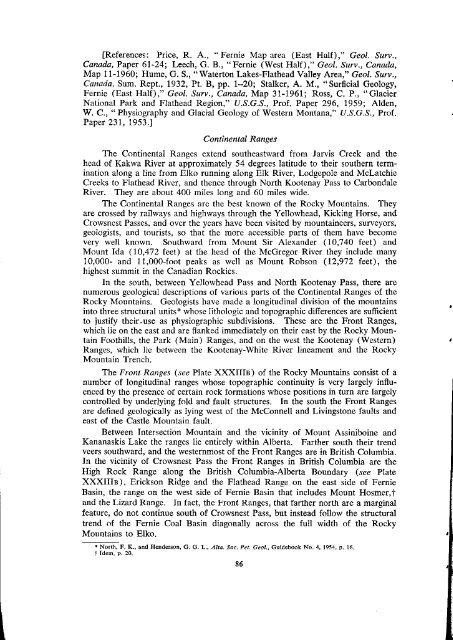Landforms of British Columbia 1976 - Department of Geography
Landforms of British Columbia 1976 - Department of Geography
Landforms of British Columbia 1976 - Department of Geography
You also want an ePaper? Increase the reach of your titles
YUMPU automatically turns print PDFs into web optimized ePapers that Google loves.
[References: Price, R. A., “ Fernie Map-area (East Half),” Geol, Surv.,<br />
Canada, Paper 61-24; Leech, G, B,, “ Fernie (West Half) ,” G&. Surv., Conada,<br />
Map 1 l-1960; Hume, G. S., “W&rum Lakes-FIathead Valley Area,” Geol. Surv.,<br />
Canada, Sum. Rept., 1932, Pt. B, pp. l-20; Stalker, A. M,, “Surficial Geology,<br />
Fernie (East Half),” Geol. Swv., Canada, Map 31-1961; Ross, C. P., “Glacier<br />
National Park and Flathead Region,” U.S.G.S., Pr<strong>of</strong>. Paper 296, 1959; Alden,<br />
W. C., “ Physiography and Glacial Geology <strong>of</strong> Western Montana,” U.S.G.S., Pr<strong>of</strong>.<br />
Paper 231, 1953.1<br />
Continental Ranges<br />
The Continental Ranges extend southeastward from Jarvis Creek and the<br />
head <strong>of</strong> Kakwa River at approximately 54 degrees latitude to their southern term-<br />
ination along a line from Elko running along Elk River, Lodgepole and McLatchie<br />
Creeks to Flathead River, and thence through North Kootenay Pass to Carbondale<br />
River. They are about 400 miles long and 60 miles wide.<br />
The Continental Ranges arc the best known <strong>of</strong> the Rocky Mountains. They<br />
are crossed by railways and highways through the Yellowhead, Kicking Horse, and<br />
Crowsnest Passes, and over the years have been visited by mountaineers, surveyors,<br />
geologists, and tourists, so that the n~ore accessible parts <strong>of</strong> them have become<br />
very well known. Southward from Mount Sir Alexander (10,740 feet) and<br />
Mount Ida (10,472 feet) at the head <strong>of</strong> the McGregor River they include nxmy<br />
lO,OOO- and 11,000.foot peaks as well as Mount Robson (12,972 feet), the<br />
highest summit in the Canadian Rockies.<br />
In the south, between Yellowhead Pass and North Kootenay Pass, there are<br />
nwnerous geological descriptions <strong>of</strong> various parts <strong>of</strong> the Continental Ranges <strong>of</strong> the<br />
Rocky Mountains, Geologists have made a longitudinal division <strong>of</strong> the mountains<br />
into three structural units* whose lithologic and topographic differences are sufficient<br />
to justify their.use as physiographic subdivisions, These are the Front Ranges,<br />
which lie on the east and are flanked immediately on their east by the Rocky Moon-<br />
tain Foothills, the Park (Main) Ranges, and on the west the Kootenay (Western)<br />
Ranges, which lie between the Kootenay-White River lineament and the Rocky<br />
Mountain Trench,<br />
The Front Ranga (xe Plate XXXIIIB) <strong>of</strong> the Rocky Mountains consist <strong>of</strong> a<br />
number <strong>of</strong> longitudinal ranges whose topographic continuity is very largely influ-<br />
enced by the presence <strong>of</strong> certain rock formations whose positions in turn are largely<br />
controlled by underlying fold and fadt structures. In the south the Front Ranges<br />
are defined geologically as lying west <strong>of</strong> the McConnell and Livingstone faults and<br />
east <strong>of</strong> the Castle Mountain fault.<br />
Between Intersection Mountain and the vicinity <strong>of</strong> Mount Assiniboine and<br />
Kananaskis Lake the ranges lie entirely within Alberta. Farther south their trend<br />
V~IXS southward, and the westernmost <strong>of</strong> the Front Ranges are in <strong>British</strong> <strong>Columbia</strong>,<br />
In the vicinity <strong>of</strong> Crowsnest Pass the Front Ranges in <strong>British</strong> <strong>Columbia</strong> are the<br />
High Rock Range along the <strong>British</strong> <strong>Columbia</strong>-Alberta Boundary (xx Plate<br />
XXXIIIB), Erickson Ridge and the Flathead Range on the east side <strong>of</strong> Fcrnie<br />
Basin, the range on the west side <strong>of</strong> Fernie Basin that includes Mount Hosmer,t<br />
and the Lizard Range. In fact, the Front Ranges, that farther north are a marginal<br />
feature, do not condnue south <strong>of</strong> Crowsnest Pass, but instead follow the structural<br />
trend <strong>of</strong> the Fernie Coal Basin diagonally across the full width <strong>of</strong> the Rocky<br />
Mountains to Elko.<br />
* North, F. K.. zmd Hellde~so”,<br />
0. 0. L., ,ma, sm. Pd. Gd., O”id&cmk NO. 4, ,954, p, 16.<br />
+ Idun P. 23<br />
86











